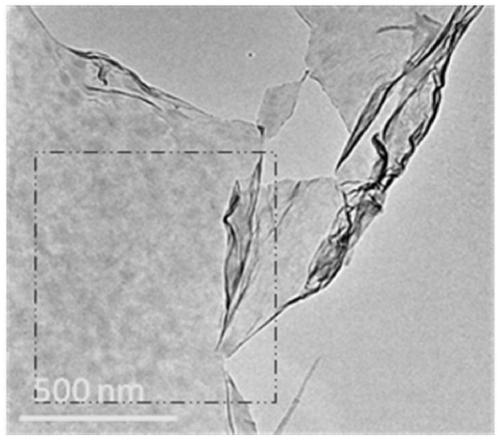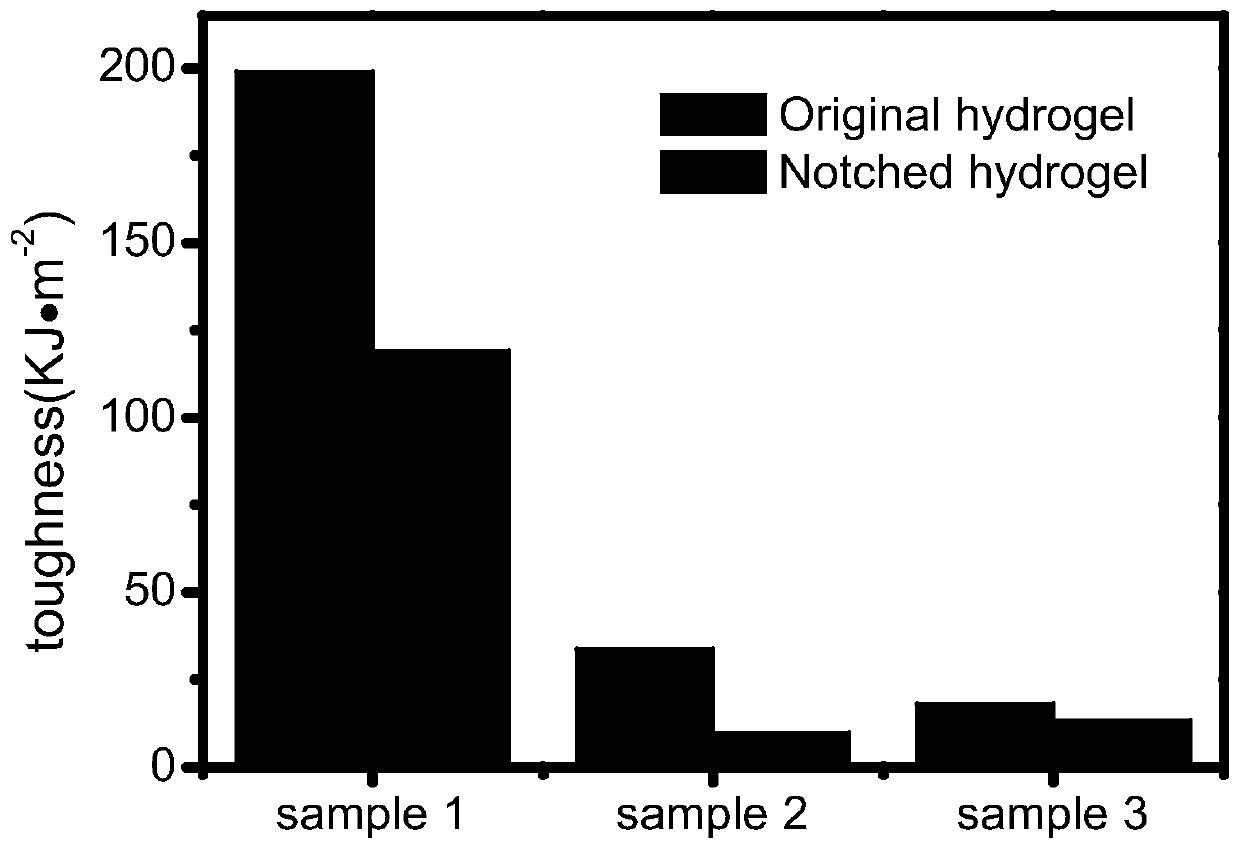Preparation method of a graphene-type nanocomposite hydrogel with anti-notch sensitivity
A nanocomposite, graphene technology, applied in the field of nanomaterials, achieves the effect of simple synthesis process, good mechanical properties and high network structure
- Summary
- Abstract
- Description
- Claims
- Application Information
AI Technical Summary
Problems solved by technology
Method used
Image
Examples
Embodiment 1
[0025] 1. Prepare 25mL of graphene oxide dispersion with a mass fraction of 0.6%, and pass nitrogen gas for 15min, heat to 70°C; weigh 0.565g N-isopropylacrylamide, 0.03g N,N-dimethylbis Add acrylamide and 0.03 g of potassium persulfate to the graphene oxide dispersion, and react for 15 minutes under a nitrogen atmosphere to obtain a graphene oxide-loaded microgel composite nanomaterial dispersion.
[0026] 2. Place the dispersion liquid obtained in step 1 in an ice-water bath, and pass nitrogen gas for 5 minutes, weigh 15% of the mass of the dispersion liquid, and add acrylamide, a hydrophilic monomer, into the dispersion liquid, stir and dissolve, and then add 0.4% of the mass of the dispersion liquid % accelerator tetramethylethylenediamine, stir and disperse evenly, and place in a vacuum drying oven to remove the air bubbles in the dispersion, and the whole process is completed under an ice-water bath;
[0027] 3. The mixed solution obtained in step 2 was pre-polymerized f...
Embodiment 2
[0029] 1. Prepare 25mL of graphene oxide dispersion liquid with a mass fraction of 0.6%, and inject nitrogen gas for 15min, and heat to 70°C;
[0030] 2. Place the dispersion liquid obtained in step 1 in an ice-water bath, and pass nitrogen gas for 5 minutes, weigh 15% of the mass of the dispersion liquid, and add acrylamide, a hydrophilic monomer, into the dispersion liquid, stir and dissolve, and then add 0.4% of the mass of the dispersion liquid % accelerator tetramethylethylenediamine, stir and disperse evenly, and place in a vacuum drying oven to remove the air bubbles in the dispersion, and the whole process is completed under an ice-water bath;
[0031] 3. Pre-polymerize the mixed solution obtained in step 2 for 2 hours in an ice bath, and then transfer it to a 60° C. oven for polymerization for 12 hours to obtain a graphene nanocomposite hydrogel.
Embodiment 3
[0033] 1. Inject nitrogen gas into 25mL deionized water for 15min, and heat to 70°C; weigh 0.565g N-isopropylacrylamide, 0.03g N,N-dimethylbisacrylamide and 0.03g potassium persulfate in sequence Adding it into the graphene oxide dispersion, and reacting for 15 minutes under a nitrogen atmosphere, to obtain a graphene oxide-loaded microgel composite nanomaterial dispersion.
[0034] 2. Place the dispersion liquid obtained in step 1 in an ice-water bath, and pass nitrogen gas for 5 minutes, weigh 15% of the mass of the dispersion liquid, and add acrylamide, a hydrophilic monomer, into the dispersion liquid, stir and dissolve, and then add 0.4% of the mass of the dispersion liquid % accelerator tetramethylethylenediamine, stir and disperse evenly, and place in a vacuum drying oven to remove the air bubbles in the dispersion, and the whole process is completed under an ice-water bath;
[0035] 3. The mixed solution obtained in step 2 was pre-polymerized for 2 hours in an ice bath...
PUM
 Login to View More
Login to View More Abstract
Description
Claims
Application Information
 Login to View More
Login to View More - R&D
- Intellectual Property
- Life Sciences
- Materials
- Tech Scout
- Unparalleled Data Quality
- Higher Quality Content
- 60% Fewer Hallucinations
Browse by: Latest US Patents, China's latest patents, Technical Efficacy Thesaurus, Application Domain, Technology Topic, Popular Technical Reports.
© 2025 PatSnap. All rights reserved.Legal|Privacy policy|Modern Slavery Act Transparency Statement|Sitemap|About US| Contact US: help@patsnap.com



